Yellowstone’s South Loop Could Reopen Next Week & Other Yellowstone Flooding Updates
This news story about new Yellowstone flood recovery updates is based on a June 17, 2022, National Park Service press release. You can read the original release here.
Four days after historic floods swept through large parts of Yellowstone National Park, the park’s recovery efforts are in full swing.
The National Park Service (NPS) said that “Yellowstone continues major flood recovery efforts in the north while repairing damage and preparing for reopening in the south.” That reopening of the South Loop could be mere days away.
While all five entrances to the park are still closed, the West, South and East entrances are “targeted for reopening as early as next week,” the Park Service said in a statement.
As water levels broke historic records on Monday, they are still unseasonably high, but have started to go down drastically on Thursday. NOAA and USGS staff are helping the park monitor and assess the chance of more flooding in the upcoming days.
In the timespan of just 96 hours, the National Park Service is now working with more than 1,000 partners in gateway communities, counties and states. This includes briefings on the impacts of the historic Yellowstone floods, as well as collaborating on reopening strategies, the Park Service said.
Crews are currently in the process of assessing damage and helping with recovery plans for the short and long term.
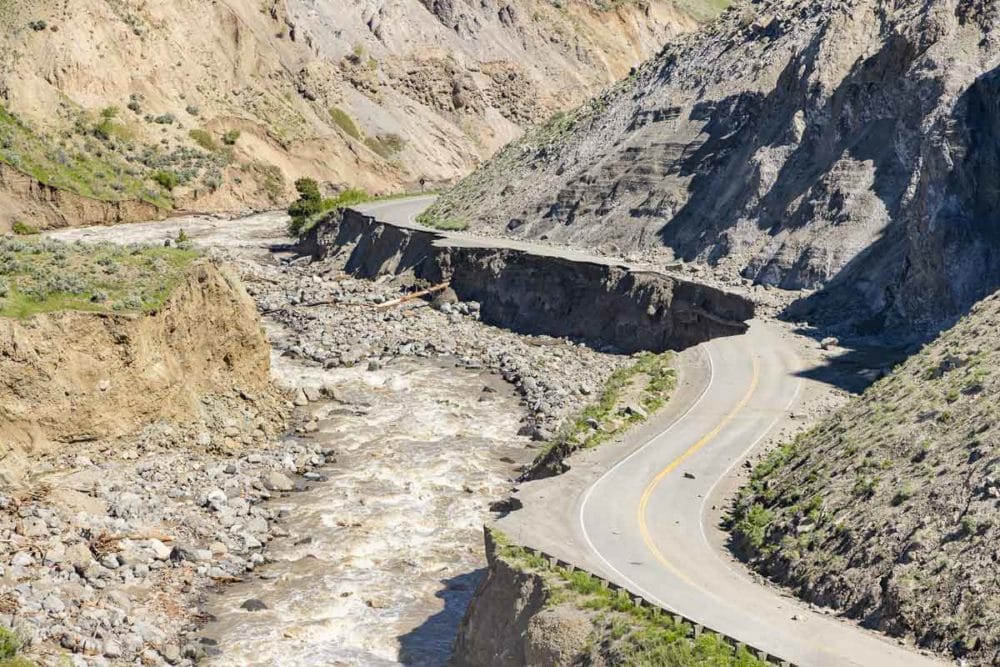
Yellowstone National Park’s South Loop Could Reopen As Soon As Next Week
The National Park Service said it is “analyzing the carrying capacity of the South Loop and working closely with partners to develop appropriate visitor management actions to safely accommodate visitors within that portion of the park.”
Additionally, other potential parts of the park that could reopen this season are also being evaluated. Those decisions will be made and communicated once the extent of the damage has been determined, along with the Park Service’s ability to reopen areas safely.
For the time being, though, the National Park Service “does not yet have an estimate on when Yellowstone will fully reopen, nor are preliminary costs for repairs and recovery available,” the agency said.
People with plans to visit Yellowstone National Park this summer will be pleased to hear the South Loop might reopen next week.
However, visiting Yellowstone will be a significantly different experience than usual for the rest of the year (and perhaps further in the future, too).
Temporarily Reservation System Might Be Coming to Yellowstone
Four million people visit the park each year, seeing spectacular hydrothermal features, observing iconic wildlife like bison and bears and enjoying scenic hikes. During the peak summer months, visitation can exceed one million people per month.
Now, because the North Loop will probably remain closed for the rest of the year, that means all these visitors will be concentrated in just the South Loop.
This is far beyond that area’s capacity, which is why the park is now looking into ways to temporarily manage visitation.
In practice, this will most likely be some kind of reservation or timed-entry system similar to other busy national parks like Arches, Rocky Mountain and Glacier.
Yellowstone National Park said it will provide more information about this temporary visitation management system soon. (We will report on this as soon as it’s been announced.)
In any case, the park reminds visitors planning to visit Yellowstone to regularly check the Yellowstone National Park website for updates.
Additionally, the park’s social media platforms are also good places to stay informed and find the most up-to-date information. You can find them on Twitter, Facebook and Instagram.
See Which National Parks Require Reservations in 2022 Here
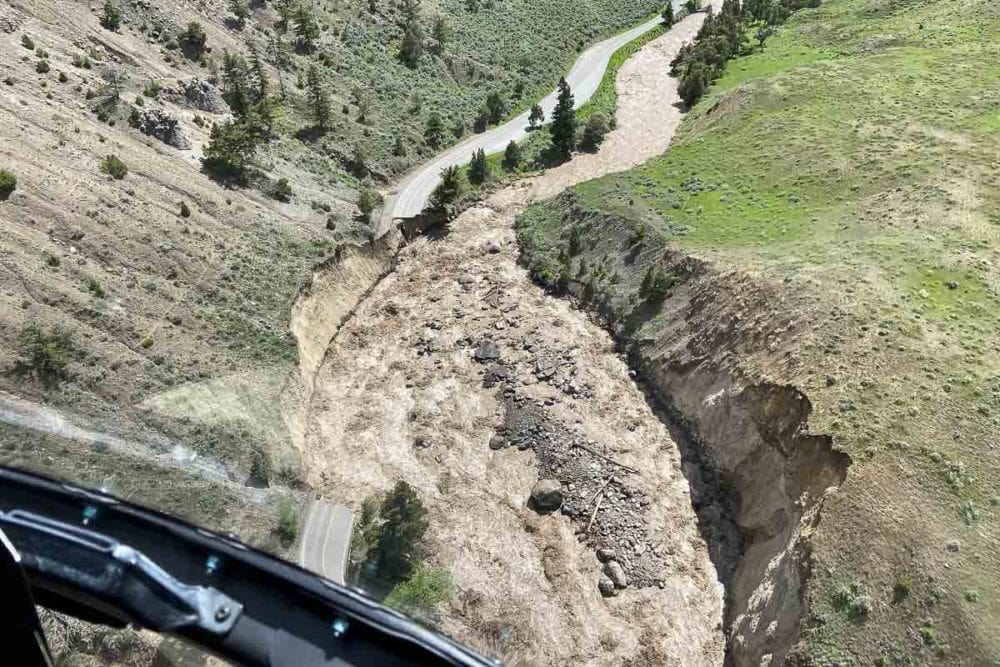
Message from the Yellowstone National Park Superintendent
“We have made tremendous progress in a very short amount of time but have long way to go,” said Superintendent Cam Sholly.
“All emergency and life safety objectives within the park have been accomplished or stabilized within the first 96 hours of the flood event, without major injury or death. We have an aggressive plan for recovery in the north and resumption of operations in the south,” he said.
Sholly also said that Yellowstone National Park appreciates “the tremendous support from National Park Service and Department of Interior leadership, in addition to our surrounding Congressional delegations, governors, counties, communities, and other partners. This first 96 hours has been critical to be able to focus on our life safety objectives and stabilizing emergency conditions while preparing plans for recovery.”
Yellowstone National Park Flood Recovery Objectives
The National Park Service shared the following objectives for recovery from the historic floods in Yellowstone. Two major zones have been determined, based on flood damage.
The North Loop, which includes Mammoth Hot Springs, Tower-Roosevelt and the Lamar Valley, is the Primary Flood Recovery Zone and will likely be closed for a significant amount of time.
The South Loop, on the other hand, which includes Old Faithful, Yellowstone Lake, Norris and Canyon, is the Operations Zone. This area (or at least parts of it) could reopen as early as the week of June 19.
North Loop (Primary Yellowstone Flood Recovery Zone)
- Ensure safety of employees, visitors, community residents and partners
- Restore and maintain basic services including, power, water, and wastewater
- Restore temporary and permanent access between Yellowstone and Gardiner
- Restore temporary and permanent road access through the Northeast Entrance Road
- Restore access to the Yellowstone backcountry
- Engage communities, local, state, and federal stakeholders, and media
South Loop (Operations Zone)
- Ensure safety of employees, visitors, and partners
- Repair damaged sections of roads and infrastructure in preparation of limited south loop reopening; inspect critical infrastructure (bridges, wastewater systems)
- Conduct extensive community outreach with gateways to identify and determine visitor use management actions necessary to host visitation on the south loop
- Develop reservation/timed entry system options for implementation with NPS visitor use experts
- Ensure internal business partners are prepared for visitor operations in the south loop
- Develop appropriate communications strategy on opening of south loop
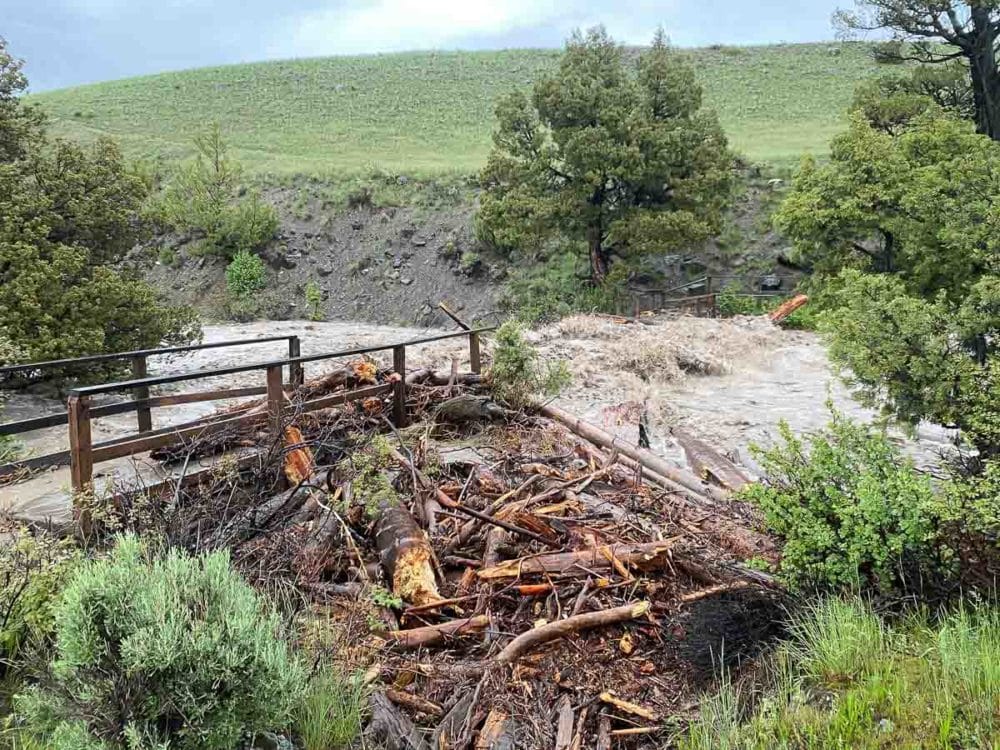
General Updates on Conditions in Yellowstone National Park
North Loop (Yellowstone Flood Recovery Zone)
- All employees continue to be safe and accounted for. Additional support programs are being established for employees impacted by the flood event.
- Employees who lost housing have been relocated to new housing units.
- Thanks to Montana Department of Transportation and Park County Montana, Highway 89 north from Gardiner was reopened on Wednesday to facilitate the exit of stranded visitors.
- Food and water supplies to Gardiner have resumed.
- Power has been restored to Yellowstone with the assistance of Northwestern Energy.
- Destroyed wastewater lines in Mammoth have been temporarily repaired with permanent repair options being planned.
- Extensive efforts have been made to improve the Old Gardiner Road to help facilitate connection of essential services and personnel from Mammoth to Gardiner. Park staff are assessing what level of improvements are needed to facilitate higher traffic levels.
- Plans and assessments of reconstruction of new the permanent road between Mammoth and Gardiner are underway. The new road will likely not be reconstructed in the same corridor as the previous road.
- Teams from Federal Highways and other agencies are in the park assisting with damage assessments and assisting the park in developing cost estimates and timeline for repair.
- Aerial 3D imaging flights have been conducted on the Northeast Entrance Road to Cooke City to help with damage assessments.
- Extensive assessments are occurring of damage to trails, bridges and infrastructure within the Yellowstone backcountry.
- Mud and rockslides have been cleared from Dunraven Pass and other sections of the northern and southern loops.
South Loop (Operations Zone)
- The park intends to reopen the South Loop sometime next week with new visitor management measures instituted (more information will be released soon). Reopening is dependent on damaged infrastructure being repaired.
- On Thursday morning, June 16, a section of damaged road collapsed south of Canyon Village. Crews will begin major repairs on Friday, June 17 with an intent to complete repairs by Monday, June 20. This repair must be completed prior to opening the south loop.
- Park staff are inspecting all bridges and roadways for damage on the south loop to facilitate safe travel.
- To ensure the South Loop infrastructure is not overwhelmed, the park is working with gateway communities and NPS visitor use experts to determine the best way to facilitate access.
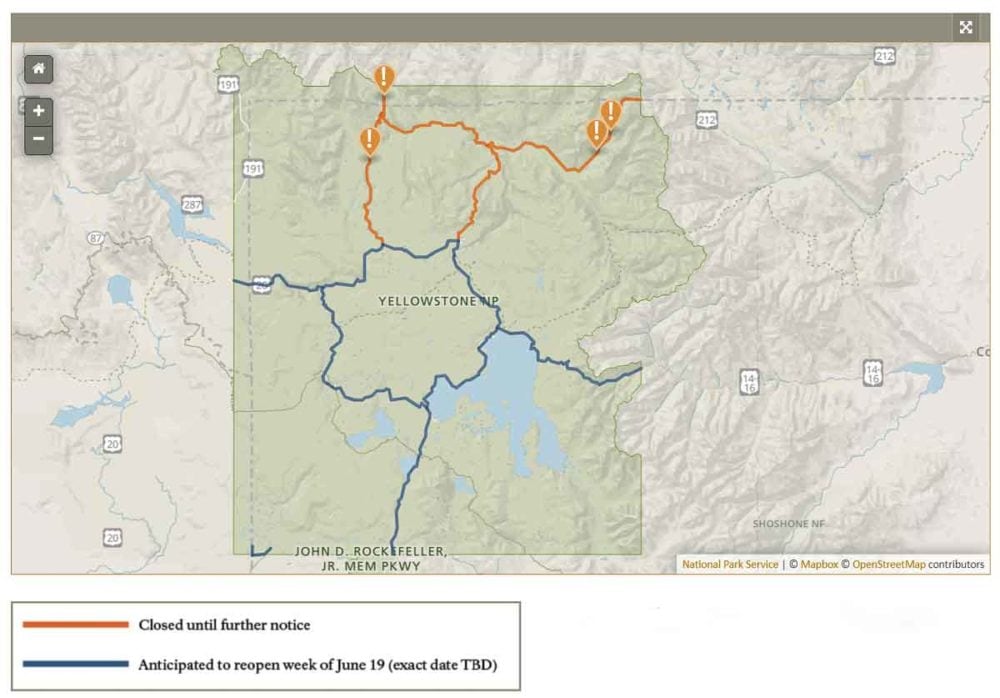
Known Damage and Issues Caused by Yellowstone National Park Flooding
- Aerial assessments conducted Monday, June 13, by Yellowstone National Park show major damage to several park roads including:
- North Entrance (Gardiner, Montana) to Mammoth Hot Springs: road washed out in multiple places, significant rockslide in Gardner Canyon
- Tower Junction to Northeast Entrance: segment of road washed out near Soda Butte Picnic Area, mudslides, downed trees
- Tower-Roosevelt to Canyon Junction (Dunraven Pass): mudslide on road
- Canyon Junction to Fishing Bridge: Segment of road just south of Canyon Junction is compromised and collapsed overnight on June 15-16. Repairs are underway.
- Many sections of road in these areas are completely gone and will require substantial time and effort to reconstruct or relocate and build.
- In some cases, roads may not be able to be reconstructed in place and will need to be relocated.
- The NPS will make every effort to repair these roads as soon as possible.
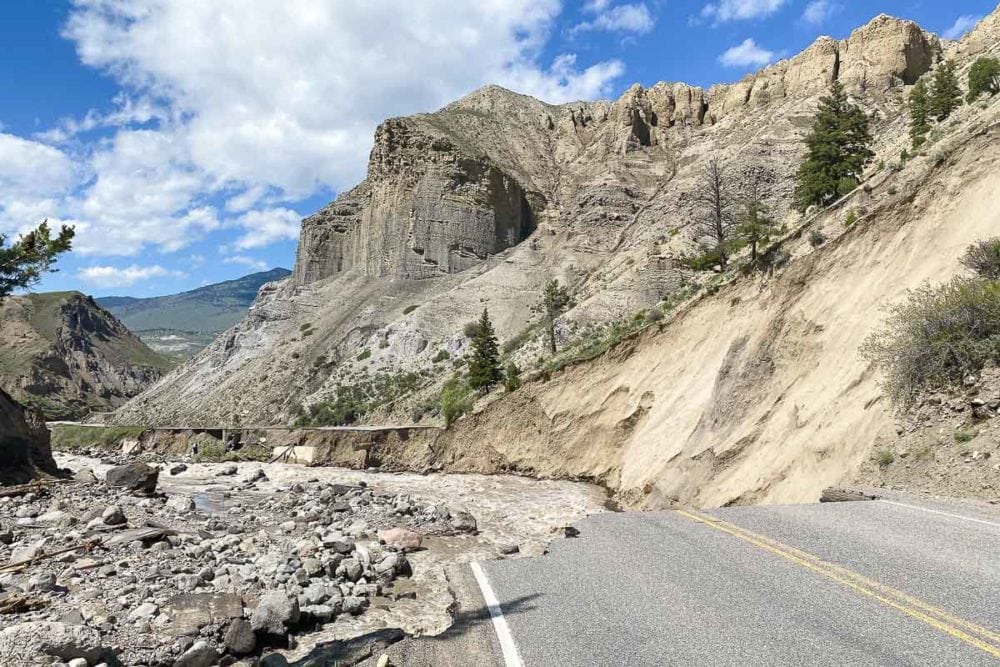
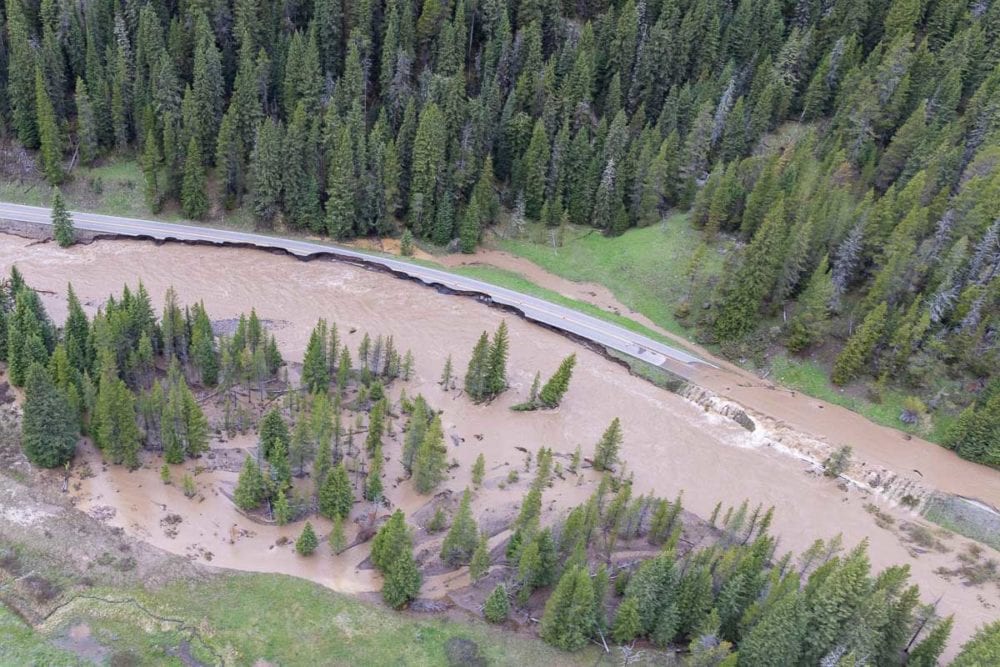
Stay Informed
Anyone who’s planning to go on a trip to Yellowstone National Park this summer should make sure they’re aware of current conditions. Future visitors should “pay close attention to the status of road and weather conditions,” the Park Service said.
You can find more information about current conditions in Yellowstone in the following ways:
- Visit the Park Roads page on the official Yellowstone website.
- Receive Yellowstone road alerts on your mobile phone. Text “82190” to 888-777 (an automatic text reply will confirm receipt and provide instructions).
- Call (307) 344-2117 for a recorded message.
- See updates on Yellowstone flood recovery efforts and park operations at go.nps.gov/YELLflood.







